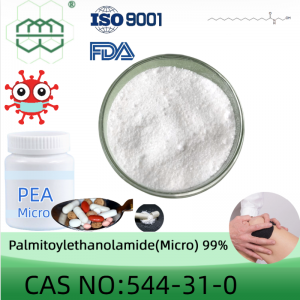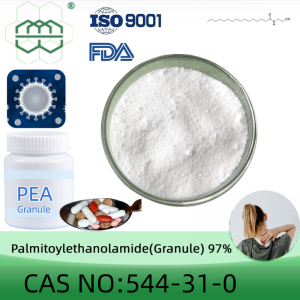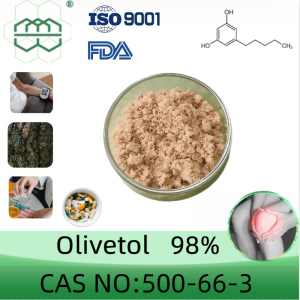Oleoylethanolamide (OEA) powder manufacturer CAS No.: 111-58-0 98%,85% purity min. for supplement ingredients
Product Parameters
|
Product name |
Oleoyl ethanolamide |
|
Other name |
N-oleoyl ethanolamine; N-(2-hydroxyethyl)-,(Z)-9-Octadecenamide |
|
CAS No. |
111-58-0 |
|
Molecular formula |
C20H39NO2 |
|
Molecular weight |
325.53 |
|
Purity |
98.0% ,85.0% |
|
Appearance |
Fine white crystal powder |
|
Packing |
1kg/bag, 25kg/drum |
|
Application |
Pain relief, anti-inflammatory |
Product introduction
Bioactive lipid amide OEA is synthesized in the gastrointestinal tract and is related to several unique steady-state properties, including anti-inflammatory activity, immune response, stimulation of fat decomposition and fatty acid oxidation. OEA is derived from omega-9 monounsaturated fatty acid oleic acid. It is considered to be an endogenous cannabinoid like lipid, and it is a receptor activated by peroxisome proliferators α (PPAR- α) Interacting and mediating anti-inflammatory processes. In addition, fatty acid ethanolamide is a lipid mediator that regulates a large number of physiological functions. Oleoyl ethanolamide (OEA), as such a biologically active lipid medium, is a peroxisome proliferator activated receptor- α (PPAR- α) An effective agonist that regulates the increased expression of fatty acid transferase CD36, thereby regulating eating behavior. In addition, OEA is an endogenous fatty acid ethanolamine produced in the intestinal mucosa. OEA anorexia signal may be the basic element of the physiological and metabolic system regulating dietary fats intake and obesity. The intake of oleic acid and the resulting OEA that endows anorexia characteristics depend on CD36, PPAR- α, Intestinal adipose sensory receptors, histamine, oxytocin, and dopamine; Causing an increase in fat oxidation and energy expenditure to induce satiety and increase feeding latency; And any interruption in these systems will stop or suppress the feeling of fullness caused by fat.
Feature
(1) Oleoyl ethanolamide (OEA) is a molecule produced in the body and typically present in the intestine.
(2) Oleoyl ethanolamide (OEA) is a molecule that regulates lipid metabolism and energy homeostasis. Therefore, OEA may have beneficial metabolic effects on NAFLD patients.
(3) Bioactive lipid amide oleoyl ethanolamide (OEA) has several unique steady-state properties, including anti-inflammatory activity, immune response regulation, and antioxidant effects,
Applications
Oleoyl ethanolamide is a natural ethanolamide lipid that can be used as a dietary program and weight regulator for various vertebrates. It is a metabolite of oleic acid formed in the human small intestine. It adheres to the PPAR Alpha receptor and helps control four factors: hunger, body fat, cholesterol, and body weight. PPAR Alpha represents the receptor alpha activated by peroxide proliferators.

















